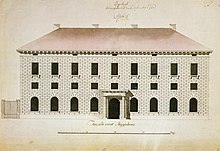Erik Palmstedt
Erik Palmstedt (born December 16, 1741 in Stockholm ; † June 12, 1803 ) was a Swedish architect . As the creator of several formative buildings in Stockholm, he is one of the most important exponents of the Gustavian style .
Life
Erik was the son of Hofkappelenspieler Johan Palmstedt and Maria Segerlund. He was trained at the school of the city architect JE Carlberg and in 1773 was appointed deputy city architect. At the age of 19, Palmstedt had already designed various houses in Stockholm independently. Palmstedt also did some work for the court before he was commissioned in 1767 with the Börsenhaus ( Börshuset ), today's domicile of the Alfred Nobel Museum. He completely changed the existing designs by the architect Cronstedt and is therefore considered the creator of the building. The house typically shows the transition from Rococo to Gustavian style.
A study trip between 1778 and 1780 took him to Rome and Paris . In the first-mentioned city he studied the architecture of antiquity , recording his feelings and the knowledge he acquired together with style analyzes and drawings in his diary. In the French capital, Palmstedt was influenced by monumental buildings and the beginnings of the baroque . This can be seen in his early buildings, which reflect the works of Jacques-François Blondel and Gilles Marie Oppenort .
Back in Sweden Palmstedt was from Gustav III. obliged to carry out renovations and extensions at Gripsholm Castle . However, he received most of the attention for the Palace of the Hereditary Prince in Stockholm. He also designed his own house in Stockholm's old town (Västerlånggatan 27) and various buildings and objects that have since fallen victim to demolition measures. In 1791 he received the title of professor and at the same time he became a member of the royal art academy . Palmstedt had already been elected to the music academy 10 years earlier . In 1802 he became rector of the architecture department at the art academy.
Various manors were built outside Stockholm, such as the courts in Heby in Södermanland and Skinnskatteberg in Västmanland , as well as several church extensions based on Palmstedt's designs.
Erik Palmstedt married Hedvig Gustava Robsahmsson in 1784, the daughter of a member of the court choir. The couple welcomed artists such as Carl Michael Bellman , Joseph Martin Kraus and Elias Martin as members of the upper class . Erik Palmstedt's son Carl (1785–1870) worked for Berzelius and later founded the Chalmers University of Technology in Gothenburg .
Other selected works from Erik Palmstedt's pen
- Bridge from Stockholm Castle to Norrmalm ( Norrbro ), 1781–1807
- Customs House ( Tullhuset ), 1783–1790
- Svartå Castle in Finland, 1783–1792
- Construction of the well on Stortorget , Stockholm Old Town, 1778
- Hildebrand house in the Rosenbad district , destroyed
- Well ( Tyska brunn ) at the former bridge to Riddarholmen , destroyed
gallery
literature
- Erik Palmstedt . In: Herman Hofberg, Frithiof Heurlin, Viktor Millqvist, Olof Rubenson (eds.): Svenskt biografiskt handlexikon . 2nd Edition. tape 2 : L – Z, including supplement . Albert Bonniers Verlag, Stockholm 1906, p. 265 (Swedish, runeberg.org ).
Web links
| personal data | |
|---|---|
| SURNAME | Palmstedt, Erik |
| BRIEF DESCRIPTION | Swedish architect |
| DATE OF BIRTH | December 16, 1741 |
| PLACE OF BIRTH | Stockholm |
| DATE OF DEATH | June 12, 1803 |




